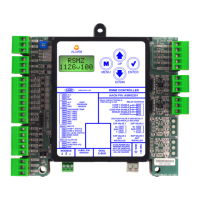36
RSMZ Technical Guide
APPENDIX A: TROUBLESHOOTING
Liquid Line and Head Pressure Transducer
Table 9: 0-667 psi Transducer Chart
0-667 psi Transducer Chart
Voltage Pressure Voltage Pressure
0.5 0 2.6 350
0.6 17 2.7 367
0.7 33 2.8 384
0.8 50 2.9 400
0.9 67 3.0 417
1.0 83 3.1 434
1.1 100 3.2 450
1.2 117 3.3 467
1.3 133 3.4 484
1.4 150 3.5 500
1.5 167 3.6 517
1.6 183 3.7 534
1.7 200 3.8 550
1.8 217 3.9 567
1.9 233 4.0 584
2.0 250 4.1 600
2.1 267 4.2 617
2.2 283 4.3 634
2.3 300 4.4 650
2.4 317 4.5 667
2.5 334
Liquid Line Pressure Transducer and
Head Pressure Transducer Testing
0-667 psi
Liquid Line Pressure Transducer Testing
The Liquid Line Pressure is obtained by using the Liquid Line
Pressure Transducer, which is connected into the Liquid Line
of the compressor.
Use the voltage column to check the Liquid Line Pressure
Transducer while connected to the Subcool Monitor Module. The
module must be powered for this test. Read voltage with a meter
set on DC volts. Place the positive lead from the meter on the
SIG input terminal located on the module. Place the negative lead
from the meter on the ground (GND) terminal located adjacent
to the SIG terminal on the module. Use a refrigerant gauge set
to measure the suction line pressure near where the Liquid Line
Pressure Transducer is connected to the discharge line. Measure
the voltage at the SIG and GND terminals and compare it to the
appropriate chart depending on the refrigerant you are using. If
the pressure/voltage readings do not align closely with the chart,
your Liquid Line Pressure Transducer is probably defective and
will need to be replaced.
Head Pressure Transducer Testing
Use the voltage column to check the Head Pressure Transducer
while connected to the RSMZ Module. The module must be
powered for this test. Read voltage with a meter set on DC volts.
Place the positive lead from the meter on the HP input terminal
located on the module. Place the negative lead from the meter on
the ground (GND) terminal located adjacent to the HP terminal
on the module. Use a refrigerant gauge set to measure the line
pressure near where the Head Pressure Transducer is connected
to the condenser. Measure the voltage at the HP and GND
terminals and compare it to the appropriate chart depending on
the refrigerant you are using. If the pressure/voltage readings do
not align closely with the chart, your Head Pressure Transducer
is probably defective and will need to be replaced.

